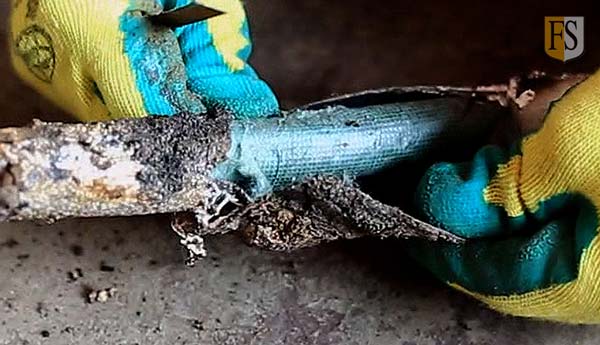Fire demonstration #1 – FS Cable Fire Protection Coating vs. Other Manufacturer vs. Uncoated Cable.
As you can see, this clearly illustrates that the outcome and level of destruction of a cable fire will depend on whether the cable is coated or not. There is also a remarkable difference on the two coatings.
VIDEO: Fire Demo 1 & 2 – FS coated cable vs others.
Visible fire protection results during the fire:
- The uncoated cable starts to melt after a few minutes.
- The intumescent fireproofing fire coating begins to expand on both of the coated cables.
- The FS coated fire protection coating on the cable is expanding far more than the cable with coating from another manufacturer.
Investigating after the fire:
Removing burnt material reveals that the FS coated cable is fully intact, while the other coated cable is severely damaged by the fire, almost as bad as the uncoated cable.
Removing the remaining FS coating and burnt material, then cutting the cable open, we discover that both the outer sheath and the inner cable shield is unharmed by the fire.
The FS1 and FS5 coating is tested to provide fire resistance in accordance with a hydrocarbon fire curve of 1100° C for one hour in accordance with the IEC 60331 regulation.
Please note that our FS 5 coating is resistant to mud, oil and chemicals. The FS 5 coating is also approved to repair and restore outer sheath of damaged cables.
The importance of a proper cable coating.
- The two blue cables in this graph illustrate the IEC 60331 standard cables that are produced to manage only 750 and 830° C.
- The yellow curve represents an I.S.O. fire, which is a normal fire in a room or in a building and can exceed 900° C.
- The red curve shows the temperature of an oil fire, which can reach up to 1100° C.
Fire Security have tested their coatings to 1100° C.
Fire Demo 2 – FS Coated Cable – Up to 1100° C.



Conclusion on cable fire coating demonstrations:
Cables are an especially weak point when it comes to fire since cable insulation will catch fire very quickly if cables are not coated with a fireproof coating. Only FS coated cables will function both during and after the fire, preventing shut down of production and costly cable repair or replacement.
Our FS1 and FS5 cable coating will also prevent the release of toxic fumes and poisonous gas from cable insulation. FS coatings are water-based and non-toxic.
Our fireproofing coatings have been approved to protect cables with the intention to ensure that signals pass through the cables when it is needed the most, like during a fire.
Learn how intumescent fireproofing is implemented on projects for cruise ship fire protection, oil rig fire protection, tanker ship fire protection, or an industrial plant fireproofing.
Contact Fire Security in Dubai, Singapore, Brazil, Mexico, USA or Norway for more information about fire protection coatings for your cables.
Fire Security – saving assets – saving lives!




